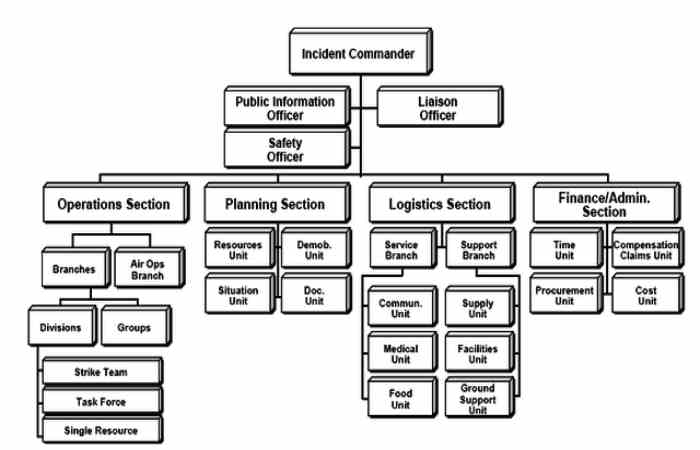Table of Contents
Which IC Function is Responsible For Documenting Mutual Aid Agreements?
The ICS function responsible for documenting mutual aid agreements is Finance/Administration. There are five main functions of the Incident Command System (ICS) that serve as the basis for developing an incident management organization.
- A Operations
- Finance/Administration
- Planning
- Incident Command
- ASSROOM MATER
- load Classroom Mater
- LE FINAL EXAM
Who is Responsible For The Modular Organization Of The ICS?

The incident commander
The Incident Commander is responsible for establishing and expanding the ICS modular organization. As the incident becomes more complex, the ICS organization can grow as functional responsibilities remain delegated.
The ICS Overview Lesson Introduces You to:
- The background and development of the ICS.
- ICS is the standard for emergency management throughout the country.
- ICS is interdisciplinary and organizationally flexible.
- ICS applications.
This lesson should take approximately 30 minutes to complete. Remember, you must
Complete the entire lesson to receive credit.
The Incident Command System (ICS)
An incident is an occurrence that requires action, whether caused by man or natural phenomena. By emergency service workers to prevent or abate loss of life or damage to property and natural resources.
Examples of incidents include:
- Fires, both structural and forestry.
- Hazardous materials situations
- Search and rescue
- Oil spills
- Pest eradication
- Control of animal diseases
- Planned events, such as parades or party-political rallies, to name a few.
Due to current budget constraints and limited staffing of local, state, and federal agencies, a single agency can’t handle all the management and resource needs for the increasing number of incidents nationwide. Local, state, and federal agencies must collaborate in a fluid and coordinated effort under the same management system.
The Incident Knowledge System or ICS remains a standardized, in-place, all-risk incident management system. Concept. ICS enables its users to adopt an integrated organizational structure that matches the complexities and demands of single or multiple incidents without being hampered by jurisdictions’ boundaries. ICS consumes considerable internal suppleness. It can produce or shrink to meet different needs. This flexibility makes it a profitable and efficient management approach for small and significant situations.
ICS organizational structure
Glossary terms:
- Agency representative
- Branch
- Boss
- Command Staff
- Director
- Division
- Finance and Administration Section
- General Staff
- Cluster
- Intelligence Section
- Leader
- Liaison Officer
- Logistics Section
- Operations Section
- Planning Section
- Public information officer
- Resource
- Security Officer
- Section
- Assault team
- Supervisor
- Workgroup
This chapter delivers more details on the organizational structure of the ICS and its role throughout the life cycle of a road incident. Describes the organizational levels that make up the ICS, focusing on its functional definition, distinctive characteristics, and relationship with other structure elements.
This chapter intended to provide highway incident professionals with a working knowledge of the numerous roles and responsibilities of crucial response personnel and the ICS chain of command considerations that govern the interrelationships of agencies at the scene of an incident. Incident on the road. It is important to note that a highway incident may require the assignment of transportation personnel to any part of the ICS organization. This can range from a single duty patrol providing support to a transportation agency in charge of incident response [for example, to perform highway incident permission functions or towing and recovery functions].
Functional structure
NIMS stipulates an ICS group of five primary functions: command, operations, planning, logistics, finance, and administration. A sixth function, Intelligence, sometimes remains additional to an ICS organization in reply to the NIMS guidance that an ICS should establish a process for collecting, sharing, and managing incident-related information and Intelligence. Exhibit 2-1 illustrates these functional areas.
Table 2-1: Basic functional structure of an incident command system
Table 2-1: Basic available structure of an incident command system. Illustration of an ICS organization consisting of six primary functions: command over operations, planning, logistics, finance and administration, and Intelligence.
Responsibilities in Each Functional Area Include:
- Command: Provides on-scene management and control authority.
- Operations: Direct Incident Tactical Operations
- Planning: Prepare the incident action plan and maintain the status of the situation and resources.
- Logistics: provide services and support to the incident.
- Finance and Administration: Track incident costs and post reimbursements
- Intelligence: Provides analysis and sharing of information and Intelligence during the incident.
Full deployment of the ICS functional structure in highway incidents remains rare. Most highway incidents need only a tiny ICS organization, often containing an incident commander (e.g., a police officer) overseeing a few resources (for example, a tow truck). ). The ICS in these minor incidents remains practiced casually without founding sections.
More complicated highway incidents need a large ICS organization to meet the span of control guidelines. The span of control refers to the maximum number of people a supervisor can manage effectively. NIMS ICS guidelines specify that the scope of control should range from three to seven individuals, with five on behalf of the average level. The size of the ICS organization must not exceed the size obligatory to meet the operational objectives of performing the work.
Also Read:

